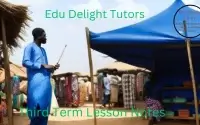Understanding the Elements of Poetry | JSS 3 Literature Lesson
Lesson Plan: Elements of Poetry
Subject: Literature in English
Class: JSS 3
Term: First Term
Week: 4
Age: 13–15 years
Topic: Elements of Poetry
Sub-topic: Understanding Key Elements of Poetry
Duration: 40 minutes
Behavioural Objectives:
By the end of the lesson, students should be able to:
- Define and identify the elements of poetry.
- Recognize rhyme, rhythm, metaphor, symbolism, imagery, and form in a poem.
- Analyze how these elements contribute to the meaning of a poem.
Keywords:
- Rhyme
- Rhythm
- Metaphor
- Symbolism
- Imagery
- Form
Set Induction:
The teacher will ask the students to think about their favorite songs and identify the repetitive sounds or patterns they notice in the lyrics. This will introduce them to the idea of rhyme and rhythm in poetry.
Entry Behaviour:
Students are familiar with songs, stories, and basic grammar.
Learning Resources and Materials:
- A recommended poem: “Stopping by Woods on a Snowy Evening” by Robert Frost.
- Whiteboard and marker
- Audio recording of the poem (optional)
Building Background/Connection to Prior Knowledge:
The teacher will connect the lesson to the previous discussion on figures of speech and literary devices. Students already know about metaphors and similes from previous lessons.
Embedded Core Skills:
- Critical thinking
- Listening and speaking skills
- Creativity
- Collaboration
Instructional Materials:
- Lagos State Scheme of Work
- Recommended poem printed or projected
Content:
Elements of Poetry
- Rhyme:
- Definition: The repetition of similar sounds in successive words, usually at the end of lines.
- Example: In “Stopping by Woods on a Snowy Evening”, lines end with similar sounds like “know” and “though”.
- Purpose: Adds musical quality and emphasizes meaning.
- Rhythm:
- Definition: The pattern of stressed and unstressed syllables in a line of poetry, like the beat of music.
- Example: “Whose woods these are I think I know.”
- Purpose: Creates movement and a sense of flow.
- Metaphor:
- Definition: A figure of speech where one thing is used to represent another.
- Example: In “Mother to Son”, life is compared to a difficult staircase.
- Purpose: Conveys complex ideas vividly and concisely.
- Symbolism:
- Definition: Using symbols to represent ideas or concepts.
- Example: In Emily Dickinson’s “Because I could not stop for Death”, death is symbolized as a carriage driver.
- Purpose: Adds depth and layered meanings to the poem.
- Imagery:
- Definition: Descriptive language that creates vivid mental pictures.
- Example: In “I Wandered Lonely as a Cloud”, Wordsworth describes daffodils swaying in the breeze.
- Purpose: Engages the senses and enhances emotional responses.
- Form:
- Definition: The overall structure of a poem, including the number of lines, rhyme scheme, and meter.
- Example: Shakespearean sonnets have 14 lines with a specific rhyme scheme.
- Purpose: Contributes to the meaning or effect of the poem.
Board Summary:
- Rhyme: Repetition of similar sounds.
- Rhythm: Pattern of stressed and unstressed syllables.
- Metaphor: One thing representing another.
- Symbolism: Use of symbols to represent ideas.
- Imagery: Descriptive language creating mental images.
- Form: Structure of the poem.
Teacher’s Activities:
- The teacher revises the previous lesson on figures of speech, asking students to give examples of metaphors or similes.
- The teacher reads the poem “Stopping by Woods on a Snowy Evening” aloud and identifies examples of rhyme, rhythm, and imagery.
- The teacher explains each element of poetry, relating it to the poem.
- The teacher invites students to discuss how these elements contribute to the poem’s overall effect.
Learners’ Activities:
- Students will listen to the poem being read aloud and identify the rhyme and rhythm.
- Students will work in pairs to find examples of metaphors, symbolism, and imagery in the poem.
- Students will discuss how the form of the poem affects its meaning.
Evaluation Questions:
- What is rhyme in poetry?
- Define rhythm and provide an example.
- How does metaphor help in poetry?
- Give an example of symbolism in poetry.
- What is imagery?
- What role does the form of a poem play?
- Name a poem that uses rhyme effectively.
- What is the difference between rhyme and rhythm?
- Identify a metaphor in “Stopping by Woods on a Snowy Evening”.
- Explain the importance of imagery in poetry.
Class Activity Discussion:
- What is the significance of rhyme in a poem?
- How does rhythm create movement in poetry?
- Can a poem exist without metaphors? Why or why not?
- How does symbolism enhance the meaning of a poem?
- Why is imagery important for readers?
- What is the difference between rhyme and rhythm?
- In what ways does form impact the reading of a poem?
- How do metaphors help simplify complex ideas?
- Which element do you think is the most important in poetry? Why?
- How does rhyme affect the sound of a poem when read aloud?
- Can symbolism be understood without explanation?
- How does the form of a poem relate to its message?
- What are examples of metaphors in everyday language?
- Why do poets use symbolism?
- What emotions do you feel when you read a poem with vivid imagery?
Conclusion:
The teacher will go around the class, mark the students’ work, and provide feedback on their answers to the evaluation questions.
